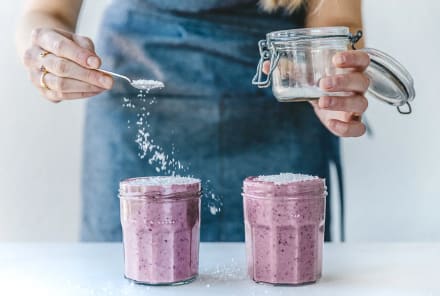Advertisement
3 Tips To Make Everyday Meals Even Healthier, From A Functional Medicine Expert


At mbg, we often preach about adding more plants to your plate. Even if you don't follow a 100 percent plant-based diet, introducing a few more fruits and veggies is never a bad idea. Adding any sort of produce already adds a bounty of health benefits, but what if we told you that you could supercharge those perks with just a few simple tweaks?
According to functional medicine expert Amy Sapola, PharmD, Director of Farmacy at The Chef's Garden in Huron, Ohio, your meal prep methods can make all the difference. On this episode of the mindbodygreen podcast, Sapola shares all of her tips and tricks to get the most nutritional bang for your buck. Check out a few highlights below.
Boil your sweet potatoes.
Usually, experts advise against boiling your vegetables, since you lose many of their valuable nutrients in the cooking water (that's what makes vegetable broth so nutritious!). "However, sweet potatoes are a very rare exception," says Sapola, especially when it comes to your blood sugar response.
"The preparation technique for a sweet potato can drastically affect the glycemic impact of the sweet potato," Sapola adds. For example, she notes that roasting sweet potatoes takes them from around 60 to 90 on the glycemic index. "So boiling sweet potatoes whole for 20 minutes covered is actually the best way to keep the glycemic impact low."
Of course, it's important to look at the whole picture rather than zeroing in on blood sugar. Sweet potatoes also boast beta carotene, fiber, magnesium, and a host of other nutrients, so if you prefer them roasted over boiled, that's A-OK. You could even try adding some protein or fat to the dish to buffer the blood sugar response.
Don't peel your veggies.
The best way to consume veggies? Leave the skin on. For example: "When you peel carrots, you're peeling off the skin, which is where most phytonutrients are found. You're also removing some of the healthy microbes that might be on there." Now, this is assuming your carrot comes from healthy, nutrient-rich soil. "Something pulled fresh out of the ground is a lot different than a carrot that has been in storage for months," Sapola adds. "As long as you're comfortable with the growing methods, you should be consuming the skin whenever you can."
The same goes for sweet potatoes, too: "That adds more fiber," Sapola notes.
Eat your leaves.
Sapola emphasizes eating the whole plant whenever possible—stems, roots, leaves, all of it! In fact, the oft-forgotten parts of a veggie actually turn out to be the healthiest. Take beets, for example: "If you look at beetroot versus beet greens, the greens—which we most often cut off and throw away—actually have more minerals than the roots themselves," Sapola says. Specifically, beet greens are rich in vitamin A, vitamin C, and polyphenols. So don't toss them!
The texture when cooked is similar to spinach, so they work great on their own as a side dish, or you can toss the greens into whatever sauté you've got on the stove. They boast a mild, sweet, and earthy flavor similar to chard. "Look at ways you can utilize the whole plant and get more bang for your buck," Sapola adds. "Instead of just throwing away part of that plant, how can you make them delicious and benefit from those minerals?"
The takeaway.
At the end of the day, simply adding more veggies to your menu is a solid move. However, if you'd like to up the ante, try Sapola's tweaks to reap even more nutritional benefits. The bottom line? "Get in as much color with your food as you can," she says. "Color is phytonutrients, and color is a sensory experience."
We hope you enjoy this episode, sponsored by Cotton! And don't forget to subscribe to our podcast on iTunes, Google Podcasts, Spotify, or Amazon Music!
Watch Next
Enjoy some of our favorite clips from classes
Enjoy some of our favorite clips from classes
What Is Meditation?
Mindfulness/Spirituality | Light Watkins
Box Breathing
Mindfulness/Spirituality | Gwen Dittmar
What Breathwork Can Address
Mindfulness/Spirituality | Gwen Dittmar
The 8 Limbs of Yoga - What is Asana?
Yoga | Caley Alyssa
Two Standing Postures to Open Up Tight Hips
Yoga | Caley Alyssa
How Plants Can Optimize Athletic Performance
Nutrition | Rich Roll
What to Eat Before a Workout
Nutrition | Rich Roll
How Ayurveda Helps Us Navigate Modern Life
Nutrition | Sahara Rose
Messages About Love & Relationships
Love & Relationships | Esther Perel
Love Languages
Love & Relationships | Esther Perel
What Is Meditation?
Box Breathing
What Breathwork Can Address
The 8 Limbs of Yoga - What is Asana?
Two Standing Postures to Open Up Tight Hips
How Plants Can Optimize Athletic Performance
What to Eat Before a Workout
How Ayurveda Helps Us Navigate Modern Life
Messages About Love & Relationships
Love Languages
Advertisement

Green Tea vs Black Tea: Caffeine, Health Benefits & When To Sip Each
Jillian Kubala, M.S., R.D.










